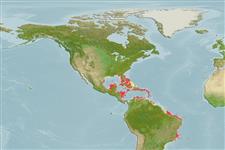>
Syngnathiformes (Pipefishes and seahorses) >
Syngnathidae (Pipefishes and seahorses) > Syngnathinae
Etymology: Micrognathus: Greek, mikros = small + greek, gnathos = jaw (Ref. 45335).
More on author: Jenyns.
Environment: milieu / climate zone / depth range / distribution range
Écologie
marin récifal; profondeur 1 - 21 m (Ref. 52313). Subtropical; 32°N - 33°S
Western Atlantic: Bermuda and the Bahamas to Santa Catarina, Brazil (Ref. 57756); including lower east Florida coast but absent from the Gulf of Mexico except for a single record from Cayo Arcas, Mexico. Dawson (1982) noted that there are two distinct color patterns of this species with no definite intergrades. Some authors are of the opinion that these color extremes represent two different species and should this be true, Dawson stated that Kaup's vittatus has priority over ensenadae with AMNH 7792 documenting the Bermuda occurrence of Micrognathus vittatus.
Taille / Poids / Âge
Maturity: Lm ? range ? - ? cm
Max length : 15.0 cm TL mâle / non sexé; (Ref. 7251)
Description synthétique
Morphologie | Morphométrie
Rayons mous dorsaux (Total): 19-21; Rayons mous anaux: 1 - 3. Possess nine (9) different color phases. Similar to Halicampus zavorensis, it has a short snout (2.7-3.7 in HL) with a continuous and essentially linear median dorsal ridges. Different with H. zavorensis in having 17-18 trunk ridges (vs. 14); 32 - 35 tail rings (vs. 36 - 37); and having 18 - 22 dorsal-fin rays (vs. 22 - 23) (Ref. 52313).
Occurs in pockets of coral rubble (low coral growth on white sand bottom), usually in the vicinity of sea fans (Ref. 5521, 7251, 9710). Ovoviviparous (Ref. 205). The male carries the eggs in a brood pouch which is found under the tail (Ref. 205).
Life cycle and mating behavior
Maturité | Reproduction | Frai | Œufs | Fécondité | Larves
Male carries the eggs in a brood pouch (Ref. 205).
Robins, C.R. and G.C. Ray, 1986. A field guide to Atlantic coast fishes of North America. Houghton Mifflin Company, Boston, U.S.A. 354 p. (Ref. 7251)
Statut dans la liste rouge de l'IUCN (Ref. 130435)
Menace pour l'homme
Harmless
Utilisations par l'homme
Plus d'informations
Taille/ÂgeCroissanceLongueur-poidsLongueur-longueurFréquences de longueursMorphométrieMorphologieLarvesDynamique des populations larvairesRecrutementAbondanceBRUVS
RéférencesAquacultureProfil d'aquacultureSouchesGénétiqueElectrophoresesHéritabilitéPathologiesTraitementNutrientsMass conversion
CollaborateursImagesStamps, Coins Misc.SonsCiguateraVitesseType de nageSurface branchialeOtolithesCerveauxVision
Outils
Articles particuliers
Télécharger en XML
Sources Internet
Estimates based on models
Preferred temperature (Ref.
123201): 25.8 - 28.2, mean 27.4 °C (based on 694 cells).
Phylogenetic diversity index (Ref.
82804): PD
50 = 0.5039 [Uniqueness, from 0.5 = low to 2.0 = high].
Bayesian length-weight: a=0.00037 (0.00016 - 0.00085), b=3.18 (2.99 - 3.37), in cm total length, based on LWR estimates for this (Sub)family-body shape (Ref.
93245).
Niveau trophique (Ref.
69278): 3.3 ±0.4 se; based on size and trophs of closest relatives
Résilience (Ref.
120179): Haut, temps minimum de doublement de population inférieur à 15 mois (Preliminary K or Fecundity.).
Fishing Vulnerability (Ref.
59153): Low vulnerability (10 of 100).
Nutrients (Ref.
124155): Calcium = 80 [38, 191] mg/100g; Iron = 0.927 [0.464, 1.736] mg/100g; Protein = 18.7 [17.4, 19.9] %; Omega3 = 0.171 [0.088, 0.330] g/100g; Selenium = 15.3 [6.4, 38.2] μg/100g; VitaminA = 45 [13, 164] μg/100g; Zinc = 1.21 [0.73, 1.96] mg/100g (wet weight);
